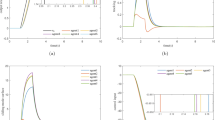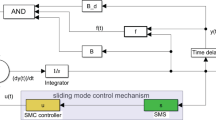Abstract
The paper presents a novel fuzzy feedback linearization control of nonlinear multi-input multi-output (MIMO) systems for the tracking and almost disturbance decoupling (ADD) performances based on the fuzzy logic control (FLC). The main contribution of this study is to construct a controller, under appropriate conditions, such that the resulting closed-loop system is valid for any initial condition and bounded tracking signal with the following characteristics: input-to-state stability with respect to disturbance inputs and almost disturbance decoupling. The feedback linearization control guarantees the almost disturbance decoupling performance and the uniform ultimate bounded stability of the tracking error system. As soon as the tracking errors are driven to touch the global final attractor with the desired radius, the fuzzy logic control immediately is applied via a human expert’s knowledge to improve the convergence rate. One example, which cannot be solved by the previous paper on the almost disturbance decoupling problem, is proposed in this paper to exploit the fact that the tracking and the almost disturbance decoupling performances are easily achieved by the proposed approach. In order to demonstrate the applicability, this paper has investigated a full-vehicle suspension system.
Similar content being viewed by others
References
A. Alleyne, A systematic approach to the control of electrohydraulic servosystems, in Proceedings of the American Control Conference, Philadelphia, PA (1998), pp. 833–837
J.A. Ball, J.W. Helton, M.L. Walker, H ∞ control for nonlinear systems with output feedback. IEEE Trans. Automat. Contr. 38, 546–559 (1993)
N.S. Bedrossian, Approximate feedback linearization: the car-pole example, in Proceedings of the 1992 IEEE International Conference on Robotics and Automation, Nice, France (1992), pp. 1987–1992
B.S. Chen, C.H. Lee, Y.C. Chang, H ∞ tracking design of uncertain nonlinear SISO systems: adaptive fuzzy approach. IEEE Trans. Fuzzy Syst. 4(1), 32–43 (1996)
M.J. Corless, G. Leitmann, Continuous state feedback guaranteeing uniform ultimate boundedness for uncertain dynamic systems. IEEE Trans. Automat. Contr. 26(5), 1139–1144 (1981)
S. Gopalswamy, J.K. Hedrick, Tracking nonlinear nonminimum phase systems using sliding control. Int. J. Control 57, 1141–1158 (1993)
M.A. Henson, D.E. Seborg, Critique of exact linearization strategies for process control. J. Process Control 1, 122–139 (1991)
J.W. Hu, J.S. Lin, Nonlinear design of full-vehicle active suspensions with backstepping control scheme, in Proceeding of 2006 CACS Automatic Control Conference, Taiwan (2006)
J. Huang, W.J. Rugh, On a nonlinear multivariable servomechanism problem. Automatica 26, 963–992 (1990)
C.J. Huang, J.S. Lin, Nonlinear backstepping control design of half-car active suspension systems. Int. J. Veh. Des. 33(4), 332–350 (2003)
S. Ikenaga, F.L. Lewis, J. Campos, L. Davis, Active suspension control of the ground vehicle based on a full-vehicle model, in IEEE Proceeding of 2000 on American Control Conference, vol. 6 (2000), pp. 4019–4024
A. Isidori, Nonlinear Control System (Springer, Berlin, 1989)
A. Isidori, H ∞ control via measurement feedback for affine nonlinear systems. Int. J. Robust Nonlinear Control 4(4), 553–574 (1994)
A. Isidori, C.I. Byrnes, Output regulation of nonlinear systems. IEEE Trans. Automat. Contr. 35, 131–140 (1990)
A. Isidori, W. Kang, H ∞ control via measurement feedback for general nonlinear systems. IEEE Trans. Automat. Contr. 40, 466–472 (1995)
S.J. Joo, J.H. Seo, Design and analysis of the nonlinear feedback linearizing control for an electromagnetic suspension system. IEEE Trans. Automat. Contr. 5(1), 135–144 (1997)
S. Kawamoto, K. Tada, A. Ishigame, T. Taniguchi, An approach to stability analysis of second order fuzzy systems, in The IEEE International Conference on Fuzzy Systems (1992), pp. 1427–1434
H.K. Khalil, Nonlinear Systems (Prentice-Hall, New York, 1996)
K. Khorasani, P.V. Kokotovic, A corrective feedback design for nonlinear systems with fast actuators. IEEE Trans. Automat. Contr. 31, 67–69 (1986)
H.K. Lam, F.H.F. Leung, P.K.S. Tam, Fuzzy state feedback controller for nonlinear systems: stability analysis and design, in The IEEE International Conference on Fuzzy Systems, vol. 2 (2002), pp. 677–681
S.Y. Lee, J.I. Lee, I.J. Ha, A new approach to nonlinear autopilot design for bank-to-turn missiles, in Proceedings of the 36th Conference on Decision and Control, San Diego, CA (1997), pp. 4192–4197
R. Marino, P.V. Kokotovic, A geometric approach to nonlinear singularly perturbed systems. Automatica 24, 31–41 (1988)
R. Marino, P. Tomei, Nonlinear output feedback tracking with almost disturbance decoupling. IEEE Trans. Automat. Contr. 44(1), 18–28 (1999)
R. Marino, W. Respondek, A.J. Van Der Schaft, Almost disturbance decoupling for single-input single-output nonlinear systems. IEEE Trans. Automat. Contr. 34(9), 1013–1017 (1989)
R.K. Miller, A.N. Michel, Ordinary Differential Equations (Academic Press, San Diego, 1982)
H. Nijmeijer, A.J. Van Der Schaft, Nonlinear Dynamical Control Systems (Springer, Berlin, 1990)
H. Peroz, B. Ogunnaike, S. Devasia, Output tracking between operating points for nonlinear processes: Van de Vusse example. IEEE Trans. Control Syst. Technol. 10(4), 611–617 (2002)
C. Qian, W. Lin, Almost disturbance decoupling for a class of high-order nonlinear systems. IEEE Trans. Automat. Contr. 45(6), 1208–1214 (2000)
J.J. Sheen, R.H. Bishop, Adaptive nonlinear control of spacecraft, in Proceedings of the American Control Conference, Baltimore, MD (1998), pp. 2867–2871
J.J.E. Slotine, W. Li, Applied Nonlinear Control (Prentice-Hall, New York, 1991)
J.P. Su, C.C. Wang, Fuzzy gain-scheduled integral control and its application to a twin rotor system. Int. J. Fuzzy Syst. 2(3), 205–219 (2000)
D. Swaroop, J.K. Hedrick, P.P. Yip, J.C. Gerdes, Dynamic surface control for a class of nonlinear systems. IEEE Trans. Automat. Contr. 45(10), 1893–1899 (2000)
K. Tanaka, M. Sugeno, Stability analysis of fuzzy control systems using Lyapunov’s direct method, in Proc. of NAFIPS’90 (1990), pp. 133–136
K. Tanaka, M. Sugeno, Stability analysis and design of fuzzy control systems. Fuzzy Sets Syst. 45(2), 135–156 (1992)
K. Tanaka, T. Hori, H.O. Wang, A multiple Lyapunov function approach to stabilization of fuzzy control systems. IEEE Trans. Fuzzy Syst. 11(4), 582–589 (2003)
A.J. Vander Schaft, L 2-gain analysis of nonlinear systems and nonlinear state feedback H ∞ control. IEEE Trans. Automat. Contr. 37, 770–784 (1992)
H.O. Wang, K. Tanaka, M.F. Griffin, An approach to fuzzy control of nonlinear systems: stability and design issues. IEEE Trans. Fuzzy Syst. 4, 14–23 (1996)
S. Weiland, J.C. Willems, Almost disturbance decoupling with internal stability. IEEE Trans. Automat. Contr. 34(3), 277–286 (1989)
J.C. Willems, Almost invariant subspace: an approach to high gain feedback design—Part I: almost controlled invariant subspaces. IEEE Trans. Automat. Contr. 26(1), 235–252 (1981)
R.R. Yager, D.P. Filev, Essentials of Fuzzy Modeling and Control (Wiley, New York, 1994)
C. Yue, T. Butsuen, J.K. Hedrick, Alternative control for automotive active suspensions. J. Dyn. Syst. Meas. Control 111, 286–291 (1989)
P.P. Yip, J.K. Hedrick, Adaptive dynamic surface control: a simplified algorithm for adaptive backstepping control of nonlinear systems. Int. J. Control 71(5), 959–979 (1998)
Author information
Authors and Affiliations
Corresponding author
Rights and permissions
About this article
Cite this article
Huang, CJ., Li, TH.S. & Chen, CC. Fuzzy Feedback Linearization Control for MIMO Nonlinear System and Its Application to Full-Vehicle Suspension System. Circuits Syst Signal Process 28, 959–991 (2009). https://doi.org/10.1007/s00034-009-9126-3
Received:
Revised:
Published:
Issue Date:
DOI: https://doi.org/10.1007/s00034-009-9126-3




